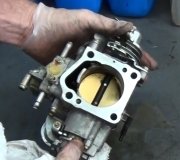1986 Jeep CJ7 6 cyl Manual
Hello from Austria!
I own a AMC Jeep CJ7 with 4, 2L 6-Cylinder Engine and Weber K551 32/36 Carburetor. The engine runs smooth and fine (high oil pressure) when it's cold or warm, but when I drive about a hour or more, the engine sometimes turns off when I use the brake at lower speed. At this time the oil pressure is very low (under 20). After this the engine doesn't have much power to accelerate and has dropouts when accelerating.
It seems like the carburetor doesn't find the idle. I do use a fuel pressure regulator (from Weber, at 3, 5 psi) and the original two output filter with fuel tank return. I have to adjust the fast idle speed many times cause it changes every day.
There is no white smoke coming out of the Exhaust and the engine looks clean and dry from the outside. No visible leakage. What can be the problem? I really don't have a clue. Oil pump? Engine Head gasket or the Weber Carburetor? Hope you can help me.
Kind regards, Alex
SPONSORED LINKS
Tuesday, July 8th, 2008 AT 2:45 PM



